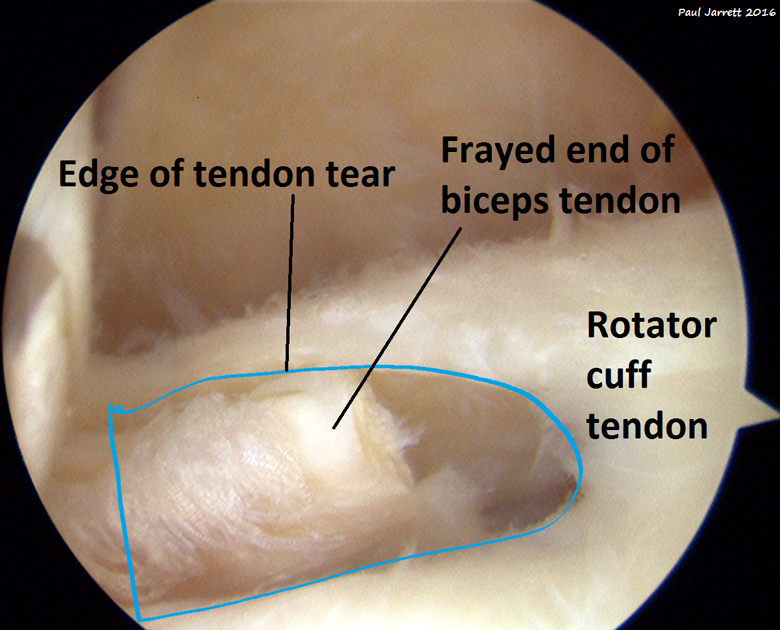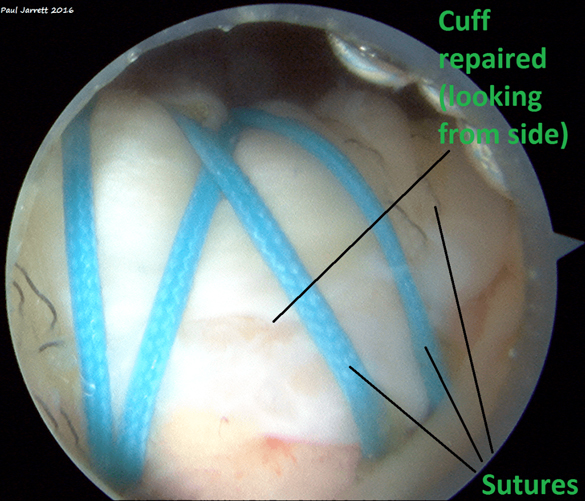
Rotator Cuff Tears
It is possible for the rotator cuff tendons to become less healthy because tendons have relatively little blood supply and can degenerate with the passage of time.
As a result, the rotator cuff tendons can tear either part way through the thickness of the tendon (partial thickness tear) or all of the way through the tendon (full thickness tear). Sometimes the surface of the tendons will be uninjured, but there can be an area of tearing within the tendon (intra-substance tear). If one or more of the rotator cuff tendons become torn, this will result in reduced shoulder function and can cause pain.
A large number of individuals in the general population, especially those in late middle-age and the elderly, have rotator cuff tears which develop over time with little symptoms. However, younger patients and some older patients with cuff tears may suffer symptoms, for which there is usually treatment available.
Partial thickness tears are often less symptomatic than full thickness tears but will become full thickness tears with time. Full thickness tears themselves can enlarge in size over time. Very large rotator cuff tears can be difficult to repair and massive rotator cuff tears can be or will become irreparable.
There is a risk that a small rotator cuff tear may become larger with time and eventually be too large to repair. However, some tendon tears do not enlarge in size with time. It remains difficult to predict if any individual’s cuff tear will become larger or more symptomatic with time.


How is a rotator cuff tear treated?
Some rotator cuff tears cause no symptoms and may not require treatment. For others, physiotherapy, steroid injections and the passage of time may be the optimal methods of treatment. Alternatively, subacromial decompression surgery to stop irritation of the tendons may be beneficial. Performing a rotator cuff repair operation can also benefit some patient’s shoulders, especially if the tear is very symptomatic, or the patient is younger.
Deciding what treatment would be best for each patient is highly individualised depending upon symptoms, shoulder functional limitations, the type and location of the rotator cuff tear, age, and general health status. The improvements the person hopes to gain and the extent they are prepared to go to achieve their aim are also taken into account.
Some partial thickness rotator cuff tears and some full thickness tears in older patients can be treated with physiotherapy, and at times, steroid injections. In these circumstances, periodic ultrasound examinations of the rotator cuff tendons may be sensible to ensure the tear does not excessively enlarge.
Younger individuals with partial thickness tears that involve a large amount of the tendon thickness (high-grade partial-thickness tears) and symptoms associated with the tear will usually benefit from having the tendon surgically repaired. Likewise, patients younger than 60 who have symptoms associated with a reasonably sized full thickness tear may benefit from rotator cuff repair. Full thickness tears in patients with modest or significant symptoms can often be assisted with surgical repair, although it is uncommon to repair rotator cuff tendons in people over 80 years of age. Tears that have come on due to degeneration may not necessarily benefit from surgery comparative to non-operative treatment.
As you can see, various factors must be carefully weighed by the patient and surgeon before making a decision on the best treatment options for the individual.
A rotator cuff tendon repair operation involves having a general anaesthetic and usually four small arthroscopy incisions, or occasionally a small open incision. Then the tendon is freed up, and the area of the humerus bone to which the tendon is attached is cleaned to allow the tendon to heal back to it. The tendon is repaired to the bone using small plastic or absorbable anchors that have stitches coming from them to attach the tendon back onto the top of the humerus bone. In addition to repairing the tendons, a small amount of bone is often shaved from the overlying acromion bone to make room for the tendon repair. Although we make this repair as durable as possible, it is initially not strong enough for normal activities and must be protected with a special shoulder sling for approximately 6 weeks. This encourages the tendon to heal to the bone which gives the repair optimal strength. It is not guaranteed that the tendon will heal back, but if it does it usually takes 9 months for the tendon repair to regain maximal strength. Therefore, you must not use your shoulder for heavy activities between 3-6 months after the operation (this length of time depends on the size of your tear, how healthy your tendon is and the speed of your recovery. If you recover your comfort quicker than normal, we may have to slow your rehabilitation).
The likelihood of the tendons healing to bone depends on several factors, including; the size of the initial tear, the length of time the tear has been present, the general strength and healing potential of the tendon itself and your rehabilitation and activities in the period following your surgery. Risks involved include infection, stiffness, including developing a frozen shoulder, re-rupture of the cuff repair, some persistent symptoms, and nerve and blood vessel injury (rare).
In some cases, when a rotator cuff tear is too large to be repaired, some forms of surgery may offer some benefit, these include; arthroscopic removal of impinging areas of bone and tissue, tendon transfer surgery or shoulder replacement. However, these forms of treatment cannot offer the same degree of improvement and long-term function like a successful rotator cuff repair can.
How to put on or take off a shoulder sling.
Rotator Cuff Repair
– Post-Operative Care
Patients usually spend one night in hospital following their subacromial decompression. No structures are repaired during this type of surgery. Therefore you can rehabilitate and use your shoulder as much as comfort allows. A sling can be worn for comfort, but its use is not essential. Mr Jarrett encourages you to reduce the use of the sling rapidly over a few days. Exercises are commenced immediately following the procedure.
Wound dressings are changed the day after your surgery, and all dressings can be removed 10 days postoperatively by yourself. You can then wash your skin including your wound as normal and moisturise your skin once or twice daily. It is unlikely you will have any sutures present but if any sutures have been used they will be absorbable. When you wash your shoulder over the next few days, they will fall out. There is a video on our website that may find helpful, with details on how to remove your dressings and what to expect after surgery.
Full recovery will take many months but most daily activities can usually be undertaken after 6 weeks, and by 3 months the shoulder should be sufficiently recovered to allow a majority of activities.
